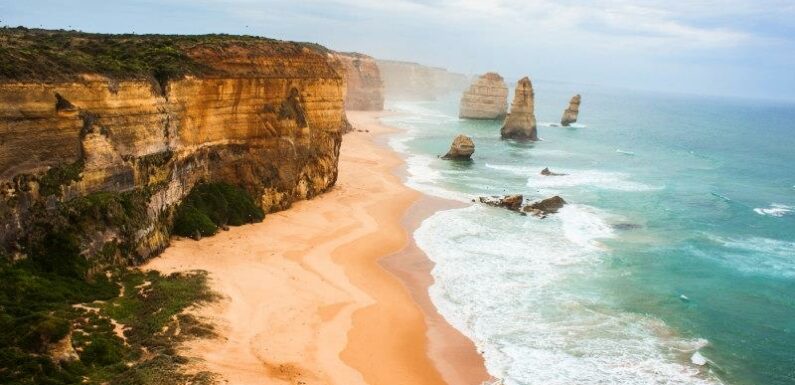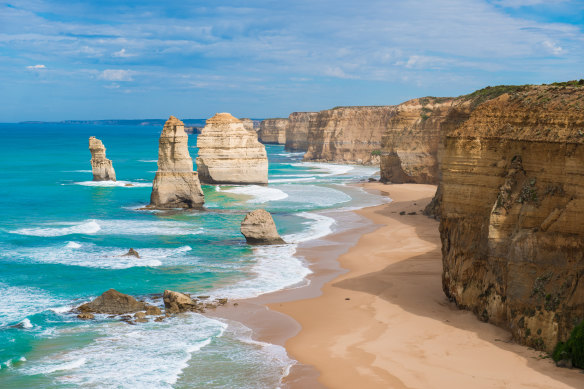
The limestone stacks of the Twelve Apostles, which jut out of Victoria’s cold surf on the Great Ocean Road, are among the state’s most popular tourist attractions: in 2019, 2.8 million people made the winding pilgrimage to look at them.
But few look at them like Stephen Gallagher. He hopes to change the way others look too.
The Twelve Apostles on Victoria’s Great Ocean Road show millions of years worth of changing climates.Credit:iStock
Gallagher, a micropalaeontologist at the University of Melbourne, does not see rock. He sees time.
The Apostles are Victoria’s deep time capsules, he says. They bear marks from when the world was much warmer and the ocean much higher – the kind of world the climate crisis is hurtling us towards.
“The past is repeated in the future,” Gallagher says.
The Twelve Apostles are seven (eight, before a 2005 collapse) sea stacks off the coast of Port Campbell. To the tourists who flock to them, they seem made of hard rock, but Gallagher’s study of them reveals they are made of life itself.
The layers of the stacks are mostly made of tiny fossilised protozoans – single-celled creatures – and other seashells, including fragments of sea urchin and clam. Each gram of Apostle contains up to 30,000 of these fossils.
That makes the Apostles geological records of the ocean – its chemical make-up and what was living in it – from between seven and 15 million years ago.
“What I see in something like the rocks of the Twelve Apostles is almost like a library, a history of what’s happened,” says Professor Alan Collins, who studies the evolution of the deep Earth at the University of Adelaide.
Much of Port Campbell sits on the same limestone – the whole area was once a shallow marine bay, which the sea is slowly eroding. But it is only at the Twelve Apostles where that history is fully exposed and available for study.
Despite that, they have received almost no serious scientific study until Gallagher started working on them last year.
“They are on all the tourist brochures. You’d imagine everyone knows everything about the layers – but it turns out there’s virtually nothing.”
And they cover what Gallagher calls a crucial “pivot point” in our recent history.
Each layer of limestone represents a few tens of thousands of years; an entire stack records many millions of years of history, a length so vast – modern humans are just 315,000 years old – geologists call it “deep time”.
The colours record the ocean’s depth, with the yellowy-browns laid down by shallow water. Trace all the way down to the dark layers of clay laid down by deeper ocean at the stacks’ base and you travel back in time 13 million years.
Earth was much warmer, and sea levels were much higher. Antarctica was almost iceless. Working on rocks at the base, Gallagher has discovered microfossils that wouldn’t look out of place in the tropics.
Those microfossils show the large changes life has to make to adapt to warmer temperatures. But life had a lot of time to make that change.
“As far as we can tell – and this is something difficult to grip – the earth’s temperature has never changed as fast as it’s changing at the moment,” says Collins.
The fossils and limestone that make up the sea stacks are carbon; coal forms from similar processes. But then we burn it, releasing that carbon back into the atmosphere, warming the Earth and raising sea levels.
Those rising seas will chip away and eventually claim the remaining Apostles.
That adds to the urgency of Gallagher’s study.
“We better make the most of it,” he says. “Because they are vanishing.”
Liam Mannix’s Examine newsletter explains and analyses science with a rigorous focus on the evidence. Sign up to get it each week.
Most Viewed in National
From our partners
Source: Read Full Article
